|
Thursday, June 26
- Breakfast: Canadian bacon, egg and cheese Texas toast
- Breakfast: corned beef hash and eggs
- Carolina pulled-pork sandwich
- Barbecue chicken breast
- Honey baked ham
- Buffalo chicken tender wrap
- Roast beef carvery
- White chicken chili
- Chef's choice soup
- Assorted pizza by the slice
Wilson Hall Cafe menu |
|
Friday, June 27
Dinner
Closed
Monday, July 2
Lunch
Menu unavailable
Chez Leon menu
Call x3524 to make your reservation.
|
|
All-hands meeting - Tuesday at 10:30 a.m. in auditorium
An all-hands meeting will take place Tuesday, July 1, at 10:30 a.m. in Ramsey Auditorium. Director Nigel Lockyer will provide an overview of upcoming organizational changes and introduce Tim Meyer, Fermilab's new chief operating officer.
The meeting will be followed by a coffee reception in the atrium, where you will have an opportunity to welcome Meyer.
|
Vicky White marks end of tenure as COO
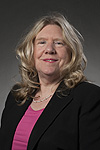 |
|
Vicky White
|
Monday, June 30, will be Vicky White's last day as Fermilab's chief operating officer, a position she has held since October 1, 2013. She plans to remain on Wilson Hall's second floor until the middle of August to assist with the transition of Tim Meyer, who takes over the role on July 1, and to complete some projects.
"Vicky has moved the laboratory ahead in several key areas during her nine months as COO, especially with regard to the DOE performance evaluation. She has also provided leadership for the Contractor Assurance System, added a well-needed structure to lab meetings, helped launch a new human resource management system and provided wise, thoughtful counsel to me," said Fermilab Director Nigel Lockyer. "Her commitment, dedication and leadership will be missed by all of her colleagues and friends."
A reception for White will be held on Monday, June 30, from 1 to 2:30 p.m. on the Wilson Hall second-floor crossover. Everyone is invited to stop by, wish her well and enjoy refreshments with colleagues.
—Deb Sebastian
|
Users Meeting 2014
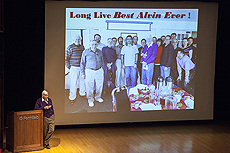 |
| At this year's Users Meeting, Fermilab staff paid tribute to scientist Alvin Tollestrup, who was instrumental in designing the Tevatron. During his tribute, Tollestrup listed the ways in which he was lucky — to have had an attentive 6th-grade teacher, a good Ph.D. advisor, and a chance to come to the Fermilab, where he helped make the Tevatron a reality. Photo: Cindy Arnold. View more photos.
|
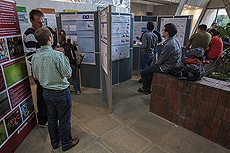 |
| The Fermilab Student and Postdoc Association poster session attracts lots of scientists. Photo: Cindy Arnold. View more photos.
|
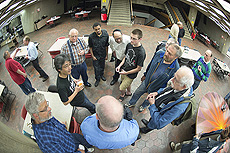 |
| Hitoshi Murayama (left, in black) of the University of Tokyo, University of California, Berkeley and Berkeley Lab gave this year's public lecture. Photo: Reidar Hahn. View more photos.
|
|
Scholars and scientists explore factors underlying serendipitous discoveries
From UChicagoNews, June 19, 2014
Editor's note: A 7-minute video on the topic of science and serendipity features scientists from Fermilab, Argonne and the University of Chicago. A video of the full Joint Speaker Event on science and serendipity is also available online.
What do Velcro, Tang, penicillin, the structure of DNA and the World Wide Web have in common?
They all involved serendipitous discoveries — chance discoveries made by alert, curious scientists who were looking for other things when they happened across a fortuitous finding. Rather than ignoring their accidental discoveries, these curious, open-minded scientists harnessed their luck. "Chance favors only the prepared mind," as Louis Pasteur put it.
Since serendipity has played such a big role in science, the Office of the Vice President for Research and for National Laboratories at the University of Chicago selected serendipity as the topic for its ninth Joint Speaker Event. The series is designed to promote dialogue and collaboration among university faculty members and scientists, researchers and engineers from Argonne National Laboratory and Fermi National Accelerator Laboratory.
Read more
|
|
Close but not equal
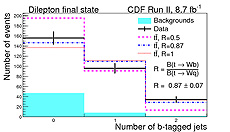 |
| This plot shows the number of events observed in the data and expected various values of R as a function of identified b jets.
|
One of the most intriguing elementary particles physicists study is the top quark. Discovered at Fermilab in 1995, it is as heavy as a tungsten atom, and its large mass implies that it decays before joining with lighter quarks to form hadrons. This gives scientists the opportunity to study its properties in detail. Our understanding of the Standard Model predicts that most of the time — 99.83 percent — the top quark decays into a W boson and a b quark.
That's the prediction. Researchers need to make a direct measurement to check it, so scientists at Fermilab and the LHC exploit their data to challenge theory and look for the unexpected.
To answer the question of how often top quarks decay into a W boson and b quark, CDF physicists looked at events in which Tevatron collisions produced a top-antitop quark pair and in which both resulting W bosons decay into an electron (or muon) and a neutrino. The electron and neutrino are accompanied by two additional jets in the final state, producing a peculiar topology.
The total sample consists of 286 events with an expected background of 55 events. (From this sample we measure the top-antitop cross section to be 7.64 ± 0.55 picobarns, which is in excellent agreement with previous measurements.)
As shown in the above figure, scientists at CDF counted how many times one, both or none of the two jets contain an identified b quark. Scientists compare this number with the total number of top decays. The comparison gives them the ratio, R, and if the Standard Model of elementary particles is correct, R should be almost 1. The result is that R is equal to 0.87 ± 0.07. It is tantalizingly close but not equal to the Standard Model expectation. The two largest contributions to the final uncertainty come from the limits in our understanding of the b-tagging efficiency and the statistical size of our sample.
Learn more
—edited by Andy Beretvas
 |
| These physicists were responsible for this analysis. From left: Georgio Chiarelli, Camilla Galloni and Sandra Leone, all from INFN, Pisa. |
|
Fermilab users: changes in obtaining and renewing a Fermilab badge
Effective June 30, the Fermilab Users Office will replace the paper forms required to get or renew a badge with electronic entries into the FermiWorks human resources management service. Laboratory users should enter their information prior to arrival to expedite the process for obtaining their badges.
After June 30, FermiWorks can be accessed 24/7 from any computer that has Internet access.
For more information about the new badging procedures, see the Users Badges FAQ. Read more about FermiWorks at the FermiWorks website.
|
It's almost time to get to know the Higgs boson better
From Science News, June 23, 2014
COPENHAGEN — Higgs boson physicists and Doctor Who fans have something in common. They've met someone new and want to get to know them better.
Since Matt Smith regenerated into Peter Capaldi last year, every Whovian has been wondering about the details of the new Doctor's personality, like how he'll interact with Clara and his other intertemporalspatial acquaintances. It seems like it has been a long time between Doctor Who seasons.
Read more
|
|